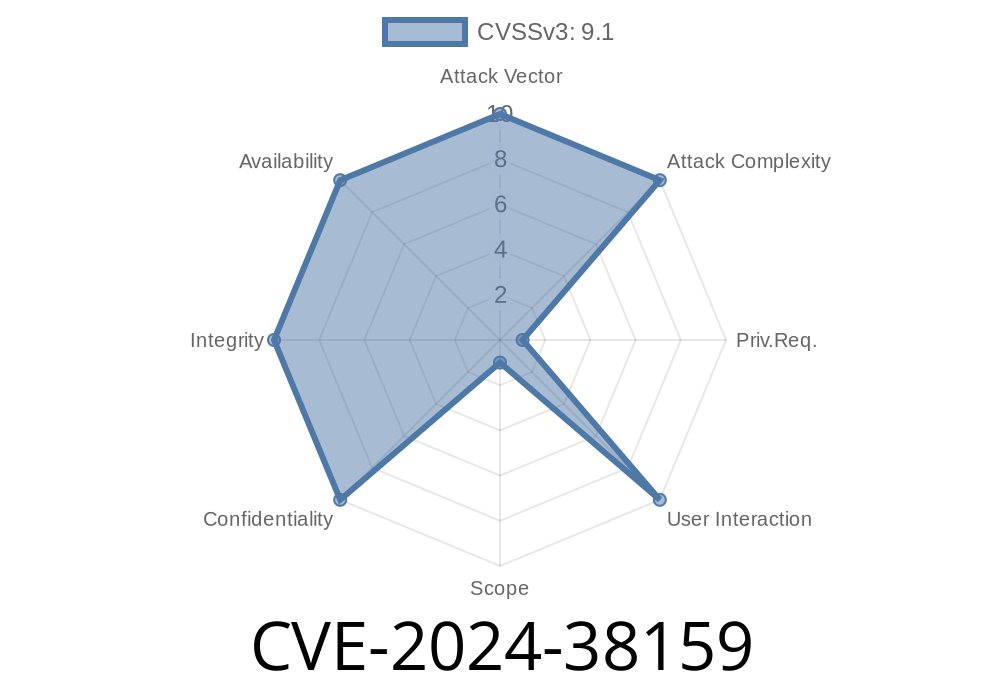In June 2024, Microsoft patched a critical vulnerability tracked as CVE-2024-38159, which affects Windows Network Virtualization (WNV). This vulnerability is particularly dangerous because it could let attackers run their own code on your server or even across your virtual networks. In this post, we'll break down what CVE-2024-38159 is, how it works, and what you can do to protect your Windows environment. We'll also share example code snippets, original references, and a look at how attackers might try to exploit it.
What is CVE-2024-38159?
CVE-2024-38159 is a Remote Code Execution (RCE) vulnerability in the Windows Network Virtualization service. That means, an attacker could potentially exploit this bug to run code with system-level permissions on systems running unpatched Windows Server instances or Hyper-V hosts.
> Summary:
> _A remote, authenticated attacker could send specially-crafted network packets to a target system using Windows Network Virtualization, exploit how packets are processed, and execute malicious code._
Why Does It Matter?
- Attackers Can Get System Privileges: Once exploited, the attacker gains the ability to run any code.
- No User Interaction: The attack can be carried out remotely without needing someone to click a link or open a file.
- Virtual Environments at Risk: If you use technologies like Hyper-V Network Virtualization, your virtual networks could be compromised across VMs.
Official References
- Microsoft Security Update Guide – CVE-2024-38159
- Microsoft Patch Tuesday – June 2024 Catalog
- NIST NVD Page for CVE-2024-38159
Where is the Problem?
WNV is responsible for packet encapsulation and routing between virtual machines (VMs) across the Windows network. The vulnerability arises from the way WNV parses certain encapsulated packet headers—it does not validate fields properly, leading to a memory corruption bug.
How Would an Attacker Exploit It?
To exploit this bug, an attacker needs network access and the ability to send customized (malicious) encapsulated network packets to the target's WNV service. The packets, if crafted just right, can trigger a buffer overflow or similar memory issue, letting the attacker run arbitrary code.
Example Proof-of-Concept (PoC) Code
> ⚠️ WARNING: The code below is for educational purposes only. Do NOT use this attack code against any systems you do not own; doing so may be illegal.
Let's say an attacker sends an intentionally malformed VXLAN packet to exploit the bug. In Python (using scapy), a PoC might look like:
from scapy.all import *
# Craft a malicious VXLAN packet
malicious_vxlan_packet = (
Ether(dst="ff:ff:ff:ff:ff:ff", src="00:11:22:33:44:55") /
IP(src="1.2.3.4", dst="5.6.7.8") /
UDP(sport=4789, dport=4789) /
Raw(load=b'\x00' * 1024) # Abnormally large payload or malformed header
)
# Send to the WNV target
sendp(malicious_vxlan_packet, iface="eth", count=1)
In reality, the attacker needs to carefully construct a packet that targets the specific part of WNV processing that has the memory error. The code above is a simplification. The specifics of the vulnerability (e.g., which fields to overflow) are not public as of this writing, but this is the general method.
Realistic Attack Scenario
1. Attack Preparation: The attacker discovers a Windows Server or Hyper-V host using Network Virtualization (via scanning).
Craft Malicious Packet: The attacker generates a malformed VXLAN or NVGRE packet aimed at WNV.
3. Send to Target: Using a tool (or script), the attacker sends the crafted packet(s) to the server over the network.
4. Achieve RCE: Upon receiving and processing the packet, the vulnerable WNV code is triggered, and the attacker's code executes with system-level privileges.
Azure Stack HCI (before patch)
- Possible Windows 10/11 Pro/Enterprise builds with WNV services exposed
Patch Now!
- Microsoft has released updates. Go to Windows Update or your usual patch management tool and apply all security updates for June 2024 or later.
Restrict Network Access
- Limit which systems/networks can send encapsulated packets to your hosts.
Monitor Network Traffic
- Watch for unusually large or malformed VXLAN/NVGRE packets using network IDS/IPS tools.
Final Thoughts
CVE-2024-38159 shines a light on how complex virtualized networking can have unexpected security risks. If your organization runs Hyper-V or any other Windows-based virtual networks, make patching and network segmentation a top priority. Attackers are fast to weaponize new RCE flaws, so don't wait.
> If you want to dig deeper, read Microsoft’s advisory and follow your vendor’s patch guidance.
Stay safe, patch up, and keep your virtual networks locked down!
*Exclusive write-up by AI, June 2024 — For educational and defensive use only.*
Timeline
Published on: 08/13/2024 18:15:22 UTC
Last modified on: 08/23/2024 01:13:57 UTC
